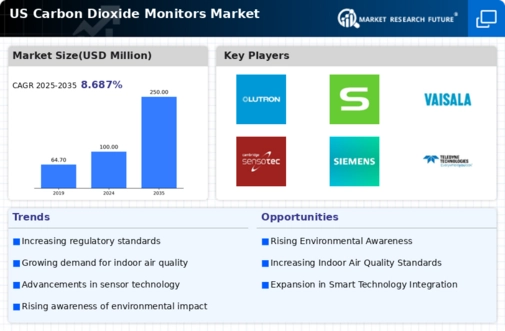The carbon dioxide-monitors market is currently characterized by a dynamic competitive landscape, driven by increasing awareness of air quality and regulatory pressures for environmental sustainability. Key players such as Honeywell (US), Siemens (DE), and Vaisala (FI) are strategically positioned to leverage innovation and technological advancements. Honeywell (US) focuses on integrating advanced sensor technologies into its product offerings, enhancing accuracy and user experience. Siemens (DE) emphasizes digital transformation, utilizing IoT capabilities to provide real-time monitoring solutions. Meanwhile, Vaisala (FI) is committed to sustainability, developing energy-efficient monitoring systems that align with global environmental goals. Collectively, these strategies foster a competitive environment that prioritizes innovation and responsiveness to market demands.
In terms of business tactics, companies are increasingly localizing manufacturing to reduce supply chain vulnerabilities and enhance responsiveness to regional market needs. The market structure appears moderately fragmented, with several players vying for market share while also collaborating through strategic partnerships. This collective influence of key players shapes a competitive landscape that is both collaborative and competitive, as companies seek to optimize their operations while maintaining a distinct market presence.
In October 2025, Honeywell (US) announced the launch of its latest line of carbon dioxide monitors, which incorporate AI-driven analytics to provide predictive insights into air quality trends. This strategic move not only enhances the functionality of their products but also positions Honeywell as a leader in the integration of AI technology within the monitoring space. The emphasis on predictive analytics is likely to attract a broader customer base, particularly in sectors where air quality is critical, such as healthcare and education.
In September 2025, Siemens (DE) expanded its partnership with a leading tech firm to enhance its IoT capabilities in carbon dioxide monitoring. This collaboration aims to develop a cloud-based platform that allows for seamless data integration and real-time monitoring. The strategic importance of this partnership lies in its potential to revolutionize how businesses manage air quality, providing them with actionable insights that can lead to improved operational efficiency and compliance with environmental regulations.
In August 2025, Vaisala (FI) launched a new series of portable carbon dioxide monitors designed for both indoor and outdoor use. This product line is particularly significant as it addresses the growing demand for versatile monitoring solutions in various environments, from industrial settings to urban areas. By diversifying its product offerings, Vaisala is likely to capture a larger market share and respond effectively to the evolving needs of its customers.
As of November 2025, current competitive trends in the carbon dioxide-monitors market are heavily influenced by digitalization, sustainability initiatives, and the integration of AI technologies. Strategic alliances are increasingly shaping the landscape, enabling companies to pool resources and expertise to enhance product offerings. Looking ahead, competitive differentiation is expected to evolve, with a notable shift from price-based competition towards innovation, technological advancements, and supply chain reliability. This transition underscores the importance of developing robust, sustainable solutions that meet the demands of a rapidly changing market.






















Leave a Comment